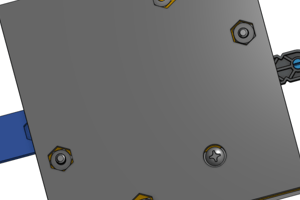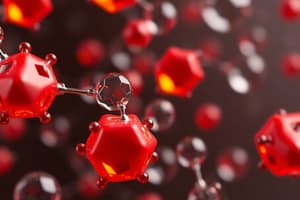Podcast
Questions and Answers
Why does continuous administration of Leuprolide lead to decreased testosterone production?
Why does continuous administration of Leuprolide lead to decreased testosterone production?
- Leuprolide downregulates the GnRH receptor in the pituitary gland, reducing LH secretion. (correct)
- Leuprolide upregulates the GnRH receptor, causing continuous stimulation and subsequent desensitization.
- Leuprolide directly inhibits testosterone synthesis in Leydig cells.
- Leuprolide acts as an agonist, increasing LH production, which inhibits testosterone production.
Which of the following is a common side effect associated with both Leuprolide and Degarelix?
Which of the following is a common side effect associated with both Leuprolide and Degarelix?
- Improved libido
- Increased bone density
- Increased muscle mass
- Hot flashes (correct)
A patient undergoing androgen abuse is likely to experience which of the following cardiovascular complications due to the treatment?
A patient undergoing androgen abuse is likely to experience which of the following cardiovascular complications due to the treatment?
- Hypotension and bradycardia
- Decreased risk of pulmonary embolism
- Myocardial infarction and cardiomegaly (correct)
- Increased HDL cholesterol levels
Which feature of 17-α alkylated androgens makes them particularly concerning for long-term use?
Which feature of 17-α alkylated androgens makes them particularly concerning for long-term use?
Why would DHT (dihydrotestosterone) administration be least likely to cause gynecomastia compared to other androgens?
Why would DHT (dihydrotestosterone) administration be least likely to cause gynecomastia compared to other androgens?
Which of the following is a primary function of testosterone in males?
Which of the following is a primary function of testosterone in males?
How does testosterone impact the production of LH and FSH?
How does testosterone impact the production of LH and FSH?
Why does testosterone have varied effects on different tissues in the body?
Why does testosterone have varied effects on different tissues in the body?
Which of the following is NOT an anabolic effect of testosterone?
Which of the following is NOT an anabolic effect of testosterone?
What is the significance of dihydrotestosterone (DHT) in androgenic activity?
What is the significance of dihydrotestosterone (DHT) in androgenic activity?
Where is testosterone primarily produced in males?
Where is testosterone primarily produced in males?
In which organ is testosterone rapidly metabolized?
In which organ is testosterone rapidly metabolized?
Which of the following side effects is most likely associated with androgen use in females due to negative feedback mechanisms?
Which of the following side effects is most likely associated with androgen use in females due to negative feedback mechanisms?
A 45-year-old male patient is diagnosed with low testosterone levels. Which of the following physiological effects might be observed in this patient due to the deficiency?
A 45-year-old male patient is diagnosed with low testosterone levels. Which of the following physiological effects might be observed in this patient due to the deficiency?
Why are 17-α alkylated androgens like methyltestosterone generally avoided for long-term use?
Why are 17-α alkylated androgens like methyltestosterone generally avoided for long-term use?
A male patient is prescribed testosterone enanthate for hypogonadism. What is the typical administration route and frequency for this medication?
A male patient is prescribed testosterone enanthate for hypogonadism. What is the typical administration route and frequency for this medication?
Nandrolone is preferred over testosterone in certain clinical scenarios because it is metabolized into dihydronandrolone, which results in which of the following?
Nandrolone is preferred over testosterone in certain clinical scenarios because it is metabolized into dihydronandrolone, which results in which of the following?
Which of the following is NOT a common side effect of androgen use in males?
Which of the following is NOT a common side effect of androgen use in males?
What is the primary mechanism by which oxymetholone treats anemia?
What is the primary mechanism by which oxymetholone treats anemia?
Why are 'alkyl' steroids less commonly used by athletes seeking performance enhancement compared to testosterone esters?
Why are 'alkyl' steroids less commonly used by athletes seeking performance enhancement compared to testosterone esters?
A patient undergoing glucocorticoid treatment experiences significant muscle wasting and weakness. Which androgen might be prescribed to promote weight gain and muscle mass?
A patient undergoing glucocorticoid treatment experiences significant muscle wasting and weakness. Which androgen might be prescribed to promote weight gain and muscle mass?
Why do oral testosterone preparations typically exhibit poor bioavailability?
Why do oral testosterone preparations typically exhibit poor bioavailability?
Which chemical modification increases the lipophilicity of testosterone, enabling intramuscular injection and slow release?
Which chemical modification increases the lipophilicity of testosterone, enabling intramuscular injection and slow release?
What is a primary reason for modifying testosterone through alkylation?
What is a primary reason for modifying testosterone through alkylation?
Following absorption, how do 17-β testosterone esters exert their effects?
Following absorption, how do 17-β testosterone esters exert their effects?
What is a significant adverse effect associated with the use of 17-α alkylated testosterone compounds?
What is a significant adverse effect associated with the use of 17-α alkylated testosterone compounds?
Which of the following is NOT a recognized therapeutic use of androgens in men?
Which of the following is NOT a recognized therapeutic use of androgens in men?
Why might testosterone esters be used in conjunction with estrogens in women?
Why might testosterone esters be used in conjunction with estrogens in women?
Which of the following side effects is specifically associated with androgen use in males?
Which of the following side effects is specifically associated with androgen use in males?
A patient with benign prostatic hyperplasia is prescribed finasteride. What is the primary mechanism of action of this medication?
A patient with benign prostatic hyperplasia is prescribed finasteride. What is the primary mechanism of action of this medication?
Flutamide is prescribed to a patient with metastatic prostate cancer alongside a GnRH analog. What is the rationale for using this combination therapy?
Flutamide is prescribed to a patient with metastatic prostate cancer alongside a GnRH analog. What is the rationale for using this combination therapy?
Which anti-androgen is most likely to cause hepatotoxicity as a significant side effect?
Which anti-androgen is most likely to cause hepatotoxicity as a significant side effect?
A patient taking an anti-androgen medication experiences gynecomastia and hot flashes. Which medication is MOST likely responsible for these side effects??
A patient taking an anti-androgen medication experiences gynecomastia and hot flashes. Which medication is MOST likely responsible for these side effects??
A researcher is investigating the effects of different anti-androgens on prostate cancer cell growth in vitro. Which anti-androgen would be MOST suitable as a selective inhibitor of DHT's action?
A researcher is investigating the effects of different anti-androgens on prostate cancer cell growth in vitro. Which anti-androgen would be MOST suitable as a selective inhibitor of DHT's action?
Dr. Voronoff's testicular graft procedure aimed to achieve what outcome?
Dr. Voronoff's testicular graft procedure aimed to achieve what outcome?
What is a potential consequence of using non-steroidal androgen receptor antagonists, such as flutamide, as a monotherapy in males?
What is a potential consequence of using non-steroidal androgen receptor antagonists, such as flutamide, as a monotherapy in males?
A patient is prescribed an anti-androgen for hirsutism. Which of the following is LEAST likely to be a side effect they experience?
A patient is prescribed an anti-androgen for hirsutism. Which of the following is LEAST likely to be a side effect they experience?
Flashcards
Testosterone
Testosterone
The major androgen in males, produced by the Leydig cells of the testes.
Testosterone's Role at Puberty
Testosterone's Role at Puberty
Steroid hormone responsible for the development of male secondary sexual characteristics at puberty.
Androgenic Effects
Androgenic Effects
Effects including maturation of sex organs, spermatogenesis, voice deepening, hair growth, and libido.
Anabolic Effects
Anabolic Effects
Signup and view all the flashcards
Testosterone Metabolites
Testosterone Metabolites
Signup and view all the flashcards
Dihydrotestosterone (DHT)
Dihydrotestosterone (DHT)
Signup and view all the flashcards
Testosterone Metabolism Site
Testosterone Metabolism Site
Signup and view all the flashcards
Testosterone Mechanism
Testosterone Mechanism
Signup and view all the flashcards
First-Pass Effect
First-Pass Effect
Signup and view all the flashcards
17-β Esterification
17-β Esterification
Signup and view all the flashcards
Alkylation of Testosterone
Alkylation of Testosterone
Signup and view all the flashcards
17-β Testosterone Esters
17-β Testosterone Esters
Signup and view all the flashcards
Androgens for Men
Androgens for Men
Signup and view all the flashcards
Androgens for Women
Androgens for Women
Signup and view all the flashcards
Side Effects in Males
Side Effects in Males
Signup and view all the flashcards
Side Effects in Females
Side Effects in Females
Signup and view all the flashcards
AAS Side Effect: Hypofertility
AAS Side Effect: Hypofertility
Signup and view all the flashcards
AAS Side Effect: Virilization
AAS Side Effect: Virilization
Signup and view all the flashcards
Leuprolide Mechanism
Leuprolide Mechanism
Signup and view all the flashcards
Leuprolide Use
Leuprolide Use
Signup and view all the flashcards
GnRH Antagonists Mechanism
GnRH Antagonists Mechanism
Signup and view all the flashcards
Anti-androgens
Anti-androgens
Signup and view all the flashcards
Finasteride/Dutasteride Mechanism
Finasteride/Dutasteride Mechanism
Signup and view all the flashcards
Finasteride/Dutasteride Use
Finasteride/Dutasteride Use
Signup and view all the flashcards
Finasteride/Dutasteride Side Effects
Finasteride/Dutasteride Side Effects
Signup and view all the flashcards
Flutamide/Bicalutamide Mechanism
Flutamide/Bicalutamide Mechanism
Signup and view all the flashcards
Flutamide/Bicalutamide Use
Flutamide/Bicalutamide Use
Signup and view all the flashcards
Flutamide/Bicalutamide Side Effects
Flutamide/Bicalutamide Side Effects
Signup and view all the flashcards
Drug combats hair loss
Drug combats hair loss
Signup and view all the flashcards
Androgen Effects in Females
Androgen Effects in Females
Signup and view all the flashcards
Androgen Effects in Males
Androgen Effects in Males
Signup and view all the flashcards
Testosterone Enanthate/Cypionate
Testosterone Enanthate/Cypionate
Signup and view all the flashcards
Testosterone Uses
Testosterone Uses
Signup and view all the flashcards
Nandrolone
Nandrolone
Signup and view all the flashcards
Oxymetholone
Oxymetholone
Signup and view all the flashcards
Oxandrolone Uses
Oxandrolone Uses
Signup and view all the flashcards
Androgens & Athletics
Androgens & Athletics
Signup and view all the flashcards
Study Notes
- Testosterone is the primary androgen, produced in the interstitial (Leydig) cells of the testes.
- Its secretion increases sharply at puberty and is responsible for the development of secondary sexual characteristics in men.
Testosterone Physiological Effects
- Androgenic effects include maturation of sex organs, stimulated spermatogenesis, voice deepening, hair growth, libido, and negative feedback on LH and FSH.
- Anabolic effects include muscle growth, bone density increase, stimulation of linear growth and bone maturation, and increased erythropoiesis via increased EPO and reduced ferritin and hepcidin.
Testosterone Metabolism
- Testosterone is converted into dihydrotestosterone and estradiol, explaining its diverse effects in different tissues.
- Dihydrotestosterone has a higher affinity for the androgen receptor than testosterone.
- Testosterone is rapidly metabolized in the liver, leading to a low oral bioavailability with only 1/6 available after oral administration due to first pass effect.
- Androsterone and Etiocholanolone are inactive metabolites excreted in the urine.
Mechanism of Action
- Testosterone and its metabolites (dihydrotestosterone and estradiol) bind to intracellular receptors, affecting gene transcription.
Therapeutic Androgen Preparations
- Poor bioavailability of oral testosterone due to first-pass effect of the liver, thus oral testosterone has been associated with liver tumors.
- Administration routes include transdermal (scrotum and skin patches, gel), buccal, IM, and SC implant.
- Chemical modifications to improve bioavailability include 17-β esterification to increase lipophilicity, enabling IM injection and slow release, also allowing oral administration as it can be absorbed via lymphatic circulation.
- Alkylation decreases hepatic catabolism, improving oral administration.
Testosterone Derivatives
- 17-β testosterone esters are hydrolyzed slowly after absorption to release testosterone.
- Alkylated testosterone is less androgenic than testosterone, resistant to hepatic catabolism, and hepatotoxic.
Common Testosterone Preparations
- Oral preparations include testosterone undecanoate (80-200 mg per day) and 17a-methyltestosterone (10-30 mg per day).
- Intramuscular preparations include testosterone enanthate, cypionate, and propionate.
- Transdermal preparations include nonscrotal and scrotal skin patches, and transdermal gel.
Advantages and Disadvantages of Delivery Methods
- Key factors include efficacy, physiological levels, duration, self-administration, cost, local problems, and pain.
Uses of Androgens
- In men, androgens compensate for low testosterone (hypogonadism, aging) and induce puberty.
- In women, they treat breast carcinoma with metastasis (enanthate only), vasomotor symptoms of menopause, and endometriosis.
- Unapproved use includes athletic performance enhancement.
Side Effects of Androgens
- In females, side effects include facial hair growth, voice deepening, and menstrual irregularities.
- Pregnancy can cause virilization of the fetus.
- In males, side effects include acne, gynecomastia, decreased spermatogenesis, hair loss, aggressive behavior, hypertension, edema (heart failure), prostate pathologies, and premature growth cessation.
- Hepatotoxicity is a risk with 17-a alkyl compounds, potentially causing cholestasis, peliosis hepatis, and hepatocarcinoma.
Chemical Modifications
- Modifications to testosterone affect androgenic and anabolic activity.
- 17-OH group modifications favor androgenic activity, oxidation reduces it, and esterification favors anabolic activity.
Androgenic:Anabolic Activity Ratios
- Testosterone, testosterone cypionate, testosterone enanthate, and methyltestosterone have a 1:1 ratio.
- Fluoxymesterone has a 1:2 ratio, and oxymetholone has a 1:3 ratio.
17-β Esterified Androgens
- Include testosterone enanthate and cypionate, which are long-acting IM injections given every 2-4 weeks.
- Testosterone undecanoate can be administered via IM injection, and is also available orally.
- They treat hypogonadism, delayed puberty, and metastatic breast cancer.
17-β Esterified Anabolic Androgens
- Nandrolone decanoate or Phenylpropionate ester which has been discontinued is an anabolic steroid metabolized into dihydronandrolone (not DHT) or estrogen used to treat stimulating the production of erythropoietin.
- Side effects included gynecomastia, reduced, libido, erectile dysfunction and cardiovascular damage.
Alkylated Testosterone
- Includes Methyltestosterone and Fluoxymesterone (now discontinued).
- Used to treat hypogonadism, inoperable breast cancer in premenopausal women, as well as prevention of postpartum breast pain and engorgement.
17-α Substituted Anabolic Compounds
- Oxymetholone used to treat anemia by increasing the kidney production of erythropoietin has been discontinued.
- Oxandrolone which is a 17-α substituted anabolic compound is discontinued, used to promote weight gain after surgery, illness, trauma or glucocorticoid treatment and treats bone pain caused by osteoporosis.
- Specific side effects include hepatic toxicity and jaundice.
Enhancement of Athletic Performance
- Androgens are used by athletes, classified as Schedule III controlled substances.
- Modern compounds include testosterone esters, hCG, and terahydrogestrinone (THG) which is rapidly metabolized and not easily detected.
- Side effects of taking for athletic purposes in males is suppression of LH levels and virilization.
- Doses for athletic purposes can cause erythrocytosis and gynecomastia-except DHT: which cannot be converted into estrogens.
- 17-a alkylated androgens are hepatotoxic, and risks include psychological disorders, change in lipid profile, and coagulation activation. Cardiovascular isides effects include MI, myocarditis, cardiomegaly, CVAs, pulmonary embolisms, sudden death, hepatomegaly and avulsions (tears).
Anti-Androgens: Leuprolide
- Leuprolide is a synthetic GnRH analog administered via subcutaneous injection and depot, or intramuscular depot.
- It acts as an antagonist in continuous fashion, down-regulating GnRH receptors in the pituitary, decreasing LH and testosterone production.
- Used to treat prostate cancer.
- Side effects include hot flashes, decreased bone density, and erectile dysfunction.
Anti-Androgens: Degarelix, Abarelix
- These are GnRH antagonists.
- They inhibit the GnRH receptor in the pituitary, decreasing FSH and LH, which causes a decrease in testosterone production.
- Primarily have been used to treat symptomatic advanced cases of prostates cancer.
- Side effects include nausea, headache, hot flashes, lower bone density, erectile dysfunction, and weigh gain.
Anti-Androgens: Finasteride, Dutasteride
- Finasteride and Dutasteride are inhibitors of 5-alpha reductase.
- They inhibit the conversion of testosterone to DHT.
- Therapeutically used for benign prostatic hyperplasia and male pattern baldness.
- Side effects include impotence, gynecomastia, and a low risk of high-grade prostate cancer.
Anti-Androgens: Flutamide, Bicalutamide, Nilutamide
- These are androgen receptor antagonists (non-steroidal).
- When used alone is known to increase production of LH and stimulates higher serum testosterone concentration.
- Used in combination with a GnRH analog to inhibit adrenal androgens (combined androgen blockade).
- Used terapeutically in men for metastatic prostate cancer
- Therapeutically used in women who have hirsutism.
- Common side effects includes hepatotoxcity, gynecomastia, hot flashes and gastrointestinal disorders like diarrhea and nausea.
Studying That Suits You
Use AI to generate personalized quizzes and flashcards to suit your learning preferences.
Related Documents
Description
Explore the effects of Leuprolide on testosterone, side effects of androgen treatments like gynecomastia, and cardiovascular risks associated with androgen abuse. Understand the role of DHT and the varied effects of testosterone across different tissues. Learn about testosterone production and its impact on LH and FSH.




